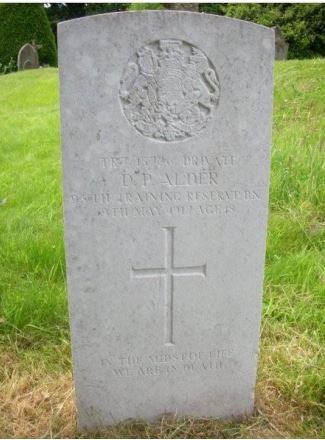95th Battalion, Training Reserve

Desmond Percy Alder was born on 13 January 1899, the twelfth and youngest child of Henry and Esther Alder who lived at Kohina Cottage, Pitchcombe near Stroud. There was 22 years age gap between George, the eldest, and Desmond.
Henry, a stonemason, and Esther married on Christmas Day 1878. Henry died on 5 December 1914 and Esther 15 years later. Both have headstones at Pitchcombe Church alongside Desmond’s. It appears that of Desmond’s seven brothers only Lionel, born on New Year’s Eve 1896, enlisted in the war, attesting on 9 December 1915. He was a qualified signaller and was posted to Malta on 5 September 1916. He survived and lived to be 91.
Brother Frank (known to the family as Toby) was rejected due to a lung condition — anecdotally, according to the family, brought on by having eaten deadly nightshade as a child. There is mention of him in the Stroud News of 18 February 1918 under the heading Military Tribunals. It appears he had tried to volunteer on three occasions and was finally passed as C3 (I think that’s what it says). He was working three days a week on a farm and was engaged in Red Cross work. ‘The Tribunal directed that he should be used as a substitute on the land.’ By 1929 he was a chauffeur.
Of Desmond’s other siblings, David emigrated to Canada in 1905 and was scalded to death on the Canadian Pacific Railway. In contrast, William became the head furrier at Selfridges. Desmond enlisted at Stroud two days after his eighteenth birthday on 15 January 1917. He had been an apprentice carpenter with local builders Burdock and Sons in Painswick. At some point he was employed by Cam Mills as he appears on their war memorial which was unveiled in November 1919.A report in the Dursley Gazette at the time states that 88 men from the Cam cloth mills enlisted with nine giving their lives.
Initially he was posted as 48220 in the 11th (Reserve Battalion), Duke of Cornwall’s Light Infantry, which became the 95th Training Reserve Battalion.
Desmond was admitted to Chiseldon Military Hospital near Swindon, on 14 April 1917 with bronchial pneumonia. He recovered from this and was discharged on 30 April. However, during convalescence he developed measles and was re-admitted on 1 May. Severe bronchial pneumonia returned and Desmond died on 9 May, aged 18, the tenth day after the appearance of the rash. He wasn’t awarded any medals.
Desmond’s funeral report was printed in the Stroud News and Journal on 11 May 1917. He was described as being of ‘a bright cheerful disposition, he was liked by everyone’. He was buried at Pitchcombe Church and is listed on the War Memorial. His grave is marked by a standard CWGC headstone.
I met with Robert and Rosemary Alder on 21 January 2011. Desmond was Robert’s uncle – Lionel being his father. I had placed a piece on the newly launched Pitchcombe and Edge Village website asking if there were any relatives of Desmond still in the area. I had an immediate response from Rosemary who was an avid family historian. The couple live on the main road at Edge just a mile or so from Pitchcombe.
I was shown Desmond’s ‘dead man’s penny’ plus a scroll of his service to the country. The couple had dozens of photos of soldiers and family members but frustratingly did not know if any were of Desmond as none had names on the back. Perhaps closer scrutiny of cap badges etc might have shed more light. We felt that we were probably looking at him. There were photos of Henry at work in a churchyard and of Esther in old age. The couple were able to give me details of the other siblings. It appears that the couple owned at least one other property in the Pitchcombe area.
Researched by Helen L Wollington 20 December 2014
